| |
|
 |
|
|
|
 |
| Vrsar |
 |
 |
The small town of Vrsar (1720 inhabitants) is situated on the Istrian west coast, a part that is also known as the Riviera of Porec. Despite being popular with tourists from all over the world, the former fishing village has managed to retain its charm and cosiness.
The name of the town (Italian: Orsera) is based on various recorded sources like ‘Ursaria’, ‘Orsaria’ and ‘Versarium’. As early as Roman times, ‘Ursaria’ has been populated, as numerous relics of old villas and findings of mosaics prove - they can be looked at at the local museum. The name of the town itself probably refers to the near townlet of Funtana, whose two springs have secured Vrsars water supply through aqueducts.
In medieval times, the town expanded uphill and was girded by a town wall, of which two town gates, wall fragments, the fort and the remains of an Early Christian basilica are preserved. |
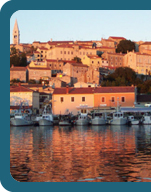 |
 |
| |
From 983 to 1778, Vrsar has been under direct administration of the bishopric Porec. In the course of the Napoleonic wars and the regency of Austria in the 19th and early 20th century, the town became its own municipality in the district of Porec.
Further events in the 20th century corresponded with those in Porec. Modern tourism dates back to the year 1961, when the offshore island of Koversada was declared a naturist area, thus being one of the ‘pioneers’ in Europe.
Vrsar had already gained famosity as a tourist place in bygone centuries, with the bishops of Porec; locating their summer residence at this place. No less a figure than the world-famous Venetian heartbreaker Giacomo Casanova - an alley in the town was named after him – has been up to mischief here: In his ‘Memories’ he remembers elaborately the charming Refoska, one of his “conquests” in Vrsar that he had kept in good memory - honi soit, qui mal y pense, Refoska being the local red grapevine… |
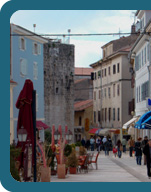 |
 |
| |
Division of the city |
|
|
| |
The specialty about Vrsar is the unmissable division of the city into two parts, with a copious waterside promenade on one side and a narrow, hilly old town on the other. The touristic life of the town happens around the bay, while 50 m uphill it seems like time has stopped half a century ago. On the other hand, a stroll east of the parish church reveals many little historic houses that have been prettily renovated, often belonging to prosperous Slovenes and foreigners from various countries like Italy, Austria, Switzerland, England and Germany. |
|
|
| |
Trg Degrassi |
|
|
| |
At the centre of the town lies the old piazza (today: Trg Degrassi) with its historic buildings. It has been the centre of everyday life for many centuries, either as a market, as the see of the episcopal saline manciple or as the church square of the small chapel Sv Anton (destroyed 1941, today it's the stylish atelier of an artist). The romantic town gate next to the tourist information is a preserved part of an old castle. |
|
|
| |
SV Foska |
|
|
| |
On the other side of the street a wooden bench invites to have a rest – with a nice view over the bay. At the east end of the old castle, today's street Rade Koncara, the small church of the local saint Sv Foska can be visited. The little church was built in the 17th century mainly in Renaissance style, but with baroque elements. This recently restored place of worship contains many sacred artifacts, most notably the titular likeness „Torture of the St. Foska“ from the 17th cent.
Next to the church you will find the Roman main gate of the town from the 13th cent. On the stone slab above the gate a bas-relief with a miniature can be seen, showing the heraldic animal of Venice. |
|
|
| |
SV Martin |
|
|
| |
The highest and most spectacular point of the old town is the conspicuous parish church Sv Martin. The campanile can be ascended (9.30am-12.30pm and 5.30pm-9.30pm). Its construction started late, in the beginning of the 19th cent., with the building of a romantic north gate on the remnants of the town wall. After the Napoleonic era (1813) the workings stopped for years; only during Josip Martinoli 's term of office, who was often compared to Don Camillo for his argumentation, has the construction been brought to completion.
Behind the church a pathway leads down to the spit of Montraker with the AC Turist, lawns for sunbathing and bathing opportunities, as well as the waterside promenade of the town. From on high, one has a splendid view over the offshore island world and can see the Eufrasius basilica of Porec in clear weather. |
|
|
| |
Episcopal palace |
|
|
| |
Right next to Sv Martin by the church square stands a multi-storied, pompous edifice - the episcopal palace (Palazzo Edbesorsa). As early as the 12th century, the bishops of Porec have owned a summer residence in Vrsar; however, initially it was notedly more modest. It was not until the 14th cent. that expansions and alterations had been made, continuing through to the 18th cent. The structure was modified with high walls including shooting towers (Turkish danger), which also earned the building the notation of 'castellum' or fort. But the high clerics' protective measures weren't motivated by considerations of foreign policy alone: Their prodigality and the splendour of the church required higher loads from the fishermen and peasants, which in 1299 lead to an uprising in Porec – whereupon bishop Bonifazius fled to the getaway castle in Vrsar. In early modern times peasants had to, among other things, carry the bishop's luggage gratuitously from Porec to Vrsar. In the 19th cent. the bishops eventually couldn't squeeze enough money out of the the people to uphold the magnificent building, and the palazzo was sold to the patrician family Vergotini of Porec. During the vicissitudes of the 20th cent. wars, the decay of the building began; but it has been restored elaborately in recent years. |
|
|
| |
Sculpture park |
|
|
| |
For lovers of modern art there is the private sculpture park of Dusan Dzamonja, one of the most famous contemporary sculptors, to be visited. Coming from Funtana his sculpture park is located just 1 km off Vrsar on the righthand side (parking area and walled-in villa, open daily except Mon, 9-11am and 7-9pm). Like many other sculptors, this most famous son of the city arose from the summer colony Montraker (the stone quarry Montraker is situated in the area of the AC Turist), where every year since 1991 students of the scuplting from all over the world try their skills and exhibt the results in town.
Just why Vrsar? The rock of this coastal strech is especially resistive to salt water. This has been known to the old Venecian architects, too: For no small number of Venecian buildings (along the Canale Grande, Mollo di Schiavi) construction material from Vrsar has been used! |
|
|
| |
Meal and drinking |
|
|
| |
In the fishing village of Funtana, the gastronomy with its 40 restaurants conglomerates in the smallest area.Here you enjoy typically istrische meals as well as Fishgulasch, Peka, shells in instruction wine sauce or a piglet of the grill with a national beverage " Medovica" , " Slivovica" or " Slivowitz" |
 |
 |
| |
Limski Bay |
|
|
| |
What is being called 'Lim Fjord' or 'Limski Channel' is geologically speaking a 9 km long, on average 600 m wide and up to 100 m deep karst valley, in which sea water mixes with the fresh water of the Lim creek that joins here. | 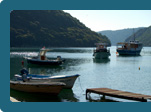 |
 |
| |
A boat tour starting from Vrsar is particularly worthwile when the weather is nice. Due to the low salinity of the water, the oxygen concentration in the fjord is very high, and fish and mussels luxuriate. Organised fishing on boats has a long tradition here, and because of the outstanding richness in fish Bishop Eufrasius of Porec summarily declared himself the sole owner of the Lim fjord in 543. The bay has stayed under the culinary supervision of stout clerics for roughly 1000 years, before the doges of Venice gave the whole Lim fjord as a 'perpetual present' to the noble family Barbabianca in 1691. Such arrangements didn't bother the freed Jugoslavia in 1945; the fjord became public domain and was announced a 'special marine reservation' in 1980. Bathing is therefore strictly prohibited. |
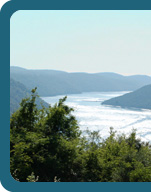 |
 |
| |
Boat trip and flight |
|
|
| |
Another viewing opportunity would be an organised boat or fishing tour from one of the seaside places. It's most convenient from Vrsar.
There is also the possibility of a sightseeing flight, starting from the airfield of Vrsar. A flight with an old biplane over Porec, Rovinj, Limski and Vrsar (30 mins) costs around 325 kuna and brings unforgettable panoramic views. |
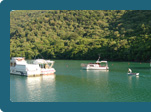 |
 |
| |
Sport & Activities |
|
|
| |
» Golf
» Cycling & Mountainbiking
» Horseback riding, Ski
» Fishery
» Aquatics
» Deving
» Tennis
» Hiking & Mountain climbing
» Sailboarding |
|
|
| |
|
|
|
| |
 |
|
| |
|
|
|
|